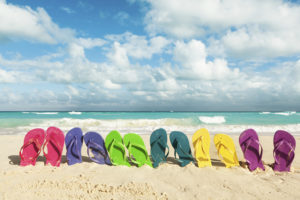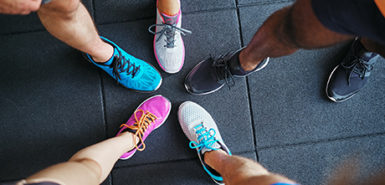
Warm weather activities seem custom-made for flip-flops.
But even Jimmy Buffett sings about how he blew out his flip-flop when he stepped on a pop top and cut his heel, then cruised on back home.
John Harris, DPM, FACFAS, a foot and ankle specialist with Spectrum Health Medical Group, certainly agrees with Buffett’s iconic lyrics. He would tell you not to wear the flip-flops in the first place. Then you wouldn’t have to worry about cutting your heel.
That’s not all Dr. Harris said about flip-flops, which he considers the scourge of the footwear world.
Top 3 reasons to throw out the flip-flops:
1. Ouch! Heel pain
The lack of suitable, or any, arch support in flip-flops can cause plantar fasciitis—heel pain or pain across the bottom of the foot.
Anyone with this lingering condition will tell you to avoid it at all costs.
2. Pain in the … ball of the foot
Not having adequate cushioning and arch support can cause soreness on the bottom of the foot.
Treatment requires more supportive shoes with effective arch support.
3. Avoid ‘flip-flop heel’
This condition is caused by walking around barefoot or wearing shoes that don’t have a back.
A thick callus rim forms around the edge of the heel when wearing shoes like flip-flops that don’t have backs to act as heel counters. This creates a situation in which your heel is constantly being exfoliated while walking. That creates a callus.
Aside from being unsightly, the cracked rim of the callus is painful.
Other flip-flip concerns
Less common, Dr. Harris said, but equally concerning are injuries from activities while wearing flip-flops.
Doctors often see ankle sprains from someone playing basketball or other sports in flip-flops, skin abrasions from a child riding a bike while wearing flip-flops, or cuts on a foot when a person wears flip-flops into a river and they slip off and float, exposing the bare foot to sharp rocks and river debris.
In addition, a study by Auburn University points out that wearing flip-flops causes you to take shorter steps and changes the way you walk compared to your gait while wearing sneakers. This can cause muscle strain.
“Instead of flip-flops, wear activity-specific shoe gear,” Dr. Harris suggested.
He pointed out that the child riding a bike should wear sneakers, the basketball player should wear basketball shoes or sneakers, and the person in the river should wear something like Keen shoes for walking in a lake or river, unless it is a sandy-bottomed lake.
“For daily wear in the summer, I’ll wear a pair of shoes similar to flip-flops,” Dr. Harris conceded. “But, I choose a shoe or sandal that has a more substantial sole and significant arch support compared to the inexpensive and flimsy flip-flops you find at stores all over town.”
There are many brands that fit this category, he said, suggesting people look for something like Chaco, Keen, Teva or Vionic.
“They’re designed to protect your foot while allowing you to engage in activities,” he said.
All in all, Dr. Harris encourages everyone to look for summer sandals that have a more substantial sole compared to those that feature a couple millimeters of foam, often found in common flip-flops, and to look for sandals with arch support rather than just a flat surface for the foot bed.
“No matter what brand you select, you still should never play basketball or mow your lawn in flip-flops,” Dr. Harris warned. “It’s just too risky.”
 /a>
/a>
 /a>
/a>
 /a>
/a>
The 3 points made against flip-flops here, “lack of arch support”, “lack of cushioning” and “callouses” are too general as they could apply to all kinds of footwear and I find this misleading. The previous article (May 27, 2018) was much more specific on the reasons to avoid flip-flops. I disagree with the presumption that these 3 things are inherently bad for feet. If your feet hurt without arch support, cushioning or callouses, I would submit that the problem might not be your footwear, but your feet!
In my experience, the real “scourge of the footwear world” is footwear itself – this belief that footwear is needed ubiquitously for locomotion and should be worn at all times. Shoes provide protection and efficiency, but most do not promote strong, healthy feet at all – and often inhibit it. So, why is the professional advice always to protect feet from the act of walking? Why always recommend cushioning and arch support instead of strengthening feet and promoting natural foot movement? Why don’t any of these articles on footwear include the recommendation: “Go barefoot often to develop strong, healthy feet with a natural motion”? Seems to me this advice alone could provide greater benefit than the suggestion of different footwear.
And, in a very measured defense of flip-flops, JB blew out his flip-flop first, and was then barefoot when he stepped on the pop top. Some people claim that the footwear’s to blame! 😉